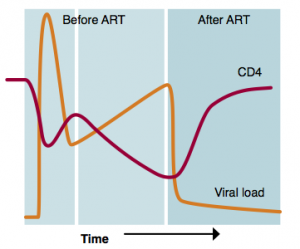The natural history of HIV in detail
 Primary HIV infection
Primary HIV infection
Primary infection usually refers to the first six months after infection.
During this period, HIV and the immune system are engaged in a very active battle.
- For the first 10 days or so, everything appears quiet. Even though HIV infection has occurred, there are rarely symptoms. The first virus – and usually it is just one virus – is picked up by an immune cell and taken to the closest lymph nodes. For most infections, the story would end here because the immune cells in the lymph nodes destroy most infections.
- With HIV something very different happens. HIV uses CD4 cells inside the lymph nodes to reproduce many times. This activity causes these lymph nodes to swell and enlarge. After two weeks the infected lymph nodes are so full that they burst. HIV then travels throughout the body.
- During the next few weeks, viral load increases to very high levels. This is often higher than 10 million copies/mL. HIV reaches every part of the body – brain, lungs, kidneys, liver etc. A large proportion of CD4 cells are permanently lost from the stomach and gut. HIV wipes out 80–90% of the total CD4 cells in your body in just a few weeks. This is long before most people are even diagnosed.
- The immune system then fights back. This process of making antibodies to HIV is called seroconversion. During these weeks, about 70% of people have symptoms. These are usually flu-like symptoms, including fevers and fatigue. Some people are hospitalised with very serious infections. The high viral load means that someone is very infectious. Seroconversion symptoms usually resolve after a week or two, but some people have no symptoms.
- Over the next few months, even without ART, viral load drops to lower levels. Your CD4 count recovers, though not as high as before infection. The first six months are therefore a very active, dynamic and busy time.
Although most people are only diagnosed during chronic infection, an increasing percentage of people in the UK are diagnosed during acute infection.
A modified CD4 test called RITA (or STARHS) can show whether infection is likely to have been within the previous 4 to 6 months.
There are many potential advantages of starting ART during this early period. During this window period, each month or week or day earlier might be associated with benefits. Very early treatment overlaps with cure research. The chance to use ART in early infection is therefore an important individual choice. See HIV reservoir and cure research.
Chronic HIV infection
- After six months, HIV enters a chronic phase. Compared to the activity during primary infection, this phase usually progresses slowly. Even without ART, many people can go for years without complications from HIV. However, over time, the CD4 count will steadily drop and viral load will steadily increase. As the CD4 count drops the risk of a serious infection increases.
- During chronic infection, especially if the CD4 count is still high, the risk from HIV complications is low. However, ART still helps at high CD4 counts. In general, starting ART sooner is better than later.
- The lower the CD4 count in chronic infection, the higher the risk from HIV-related infections. But even when the CD4 count is very high, HIV can still cause serious problems without ART. The START study showed that ART has benefits even at CD4 counts above 500.
- ART quickly reduces viral load – by 90% in a few days. Viral load should then become undetectable within 1 to 3 months. How quickly this happens depends on the choice of ART and how high viral load is.
- The CD4 count increases more slowly. But the higher the CD4 count when starting the quicker the response and the higher it will become. People starting with low CD4 counts are more likely to have a slower CD4 recovery.
- Once stable on ART, so long as adherence is good, the same combination can last for years and even decades.
Understanding test results
- It is easy to worry about CD4 and viral load results, especially when you find out you are HIV positive.
- These tests are good markers for damage caused by HIV, but there is a lot of variability in the results. The trend of several results over time is more important than a single result.
- The first CD4 count will not tell you whether you are in early or late infection. Interpreting the CD4 count with your sexual history and potential symptoms can estimate when infection occurred. For most people though this will only be a guess.
- A second set of results can show whether the trend is increasing, decreasing, or roughly stable. However, as ART is increasingly started at high CD4 counts, fewer people wait to monitor this trend.
- CD4 counts also fluctuate by the time of day, whether you have recently exercised, and eaten.
- The normal CD4 range for HIV negative people is between 400 and 1,600 cells/mm3 but people with higher or lower results can be perfectly healthy. For HIV negative people, there is no relationship between health and CD4 count.
Last updated: 1 April 2022.
